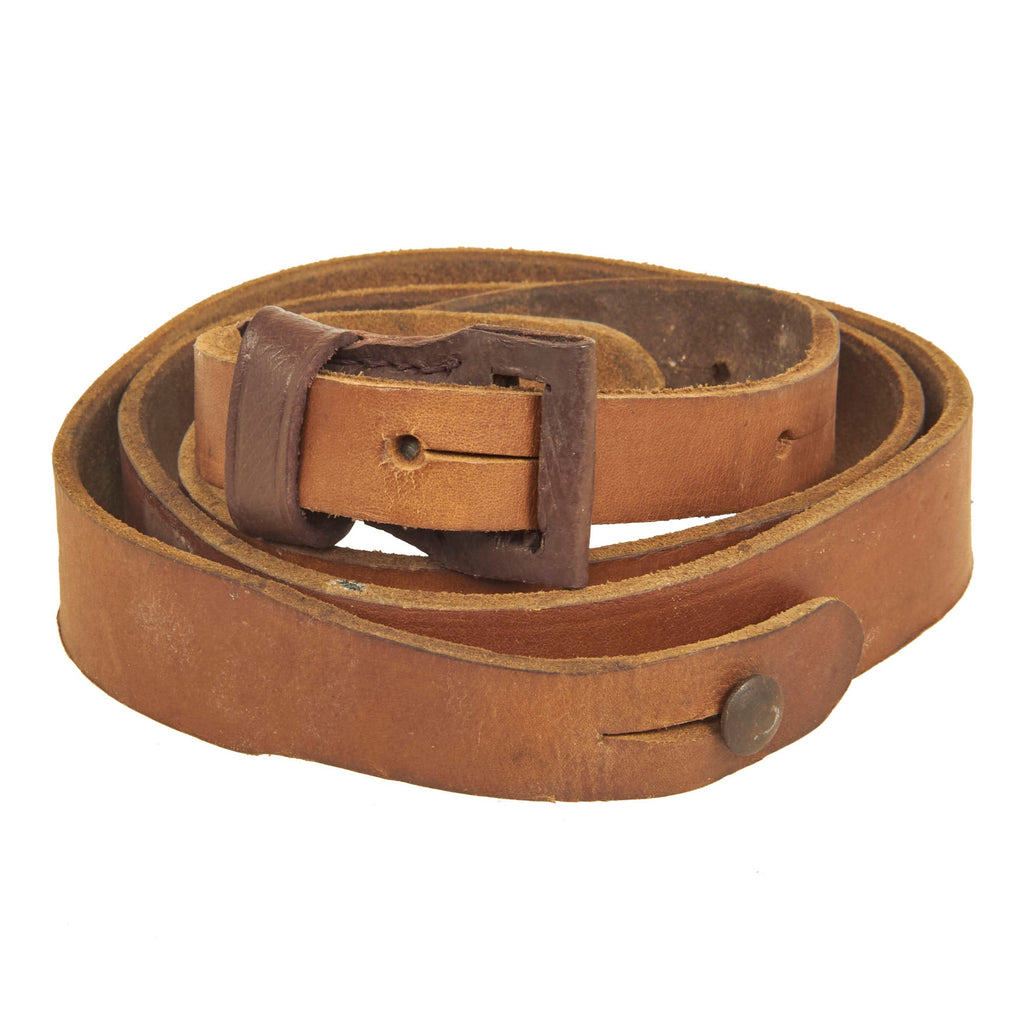Item Description
Original Item: Very Few Available. In the process of tidying up around the IMA warehouse we were fortunate to uncover some items that haven't seen the light of day in several decades, these slings being one of them! These are WWII era Leather Slings intended for use with the MP-44 Assault Rifle, or Sturmgewehr. The slings were purchased in Yugoslavia decades ago, and were utilized by the JNA for the small number of MP-44s used by their Special Forces and Airborne Units in the 1950s-1970s.
The slings are made of thick brown leather with steel hardware. Each sling is fitted with a quality reproduction sling keeper. The slings are in good, serviceable, condition Some slight variation should be expected with the slings. Some may have original markings, some have reproduction markings, small slight nuances with hardware, and so on.
Each Measures approximately 48 ¼” in length x 1” in width.
History of the MP44-
The StG 44 (Sturmgewehr 44, literally "storm/assault rifle" model of 1944 was an assault rifle developed in NSDAP Germany during World War II that was the first of its kind to see major deployment and is considered by many historians to be the first modern assault rifle. It is also known under the designations MP 43 and MP 44 (Maschinenpistole 43, Maschinenpistole 44 respectively), which denote earlier development versions of the same weapon with some differences like a different butt end, muzzle nut, shape of the front sight base or with an unstepped barrel, all only visible with close inspection.
MP 43, MP 44, and StG 44 were different designations for what was essentially the same rifle, with minor updates in production. The variety in nomenclatures resulted from the complicated bureaucracy in NSDAP Germany. Developed from the Mkb 42(H) "machine carbine", the StG44 combined the characteristics of a carbine, submachine gun and automatic rifle. StG is an abbreviation of Sturmgewehr. The name was chosen for propaganda reasons and literally means "storm rifle" as in "to storm (i.e. "assault") an enemy position". After the adoption of the StG 44, the English translation "assault rifle" became the accepted designation for this type of infantry small arm.
The rifle was chambered for the 7.92×33mm Kurz cartridge. This shorter version of the German standard (7.92x57mm) rifle round, in combination with the weapon's selective-fire design, provided a compromise between the controllable firepower of a submachine gun at close quarters with the accuracy and power of a Karabiner 98k bolt action rifle at intermediate ranges. While the StG44 had less range and power than the more powerful infantry rifles of the day, Wehrmacht studies had shown that most combat engagements occurred at less than 300 m, with the majority within 200 m. Full-power rifle cartridges were excessive for the vast majority of uses for the average soldier. Only a trained specialist, such as a sniper, could make full use of the standard rifle round's range and power.
The StG 44's receiver was made of heavy stamped and welded steel as were other contemporary arms such as the MP 40 and MG 42. This made for a fairly heavy rifle, especially one firing an intermediate-power cartridge. Difficulties with fabrication, the need to use available non-priority steels, and the exigencies of war resulted in a heavy receiver. U.S. military intelligence criticized the weight of the weapon along with the inclusion of the fully automatic feature which it considered "ineffectual for all practical purposes", convinced that full automatic fire with StG 44 was permitted in emergencies only. This was a misinterpretation of the manual however, as the German manual states that automatic fire was "advised only in emergencies", this was mainly to make sure that the regular soldier didn't unnecessarily waste his ammunition spraying at targets, but instead fired in short accurate bursts to achieve maximum accuracy and effect; the StG could easily and safely be used in full automatic mode. The British were also critical saying that the receiver could be bent and the bolt locked up by the mere act of knocking a leaning rifle onto a hard floor. Many of these criticisms are more a testimonial of the Allied aversion rather than an accurate view of the weapon's characteristics that were proven highly effective during combat in the war.
To its credit, it was the first successful weapon of its class, and the concept had a major impact on modern infantry small arms development. By all accounts, the StG 44 fulfilled its role admirably, particularly on the Eastern Front, offering a greatly increased volume of fire compared to standard infantry rifles. In the end, it came too late to have a significant effect on the outcome of the war.
- This product is available for international shipping.
- Not eligible for payment with Paypal or Amazon







